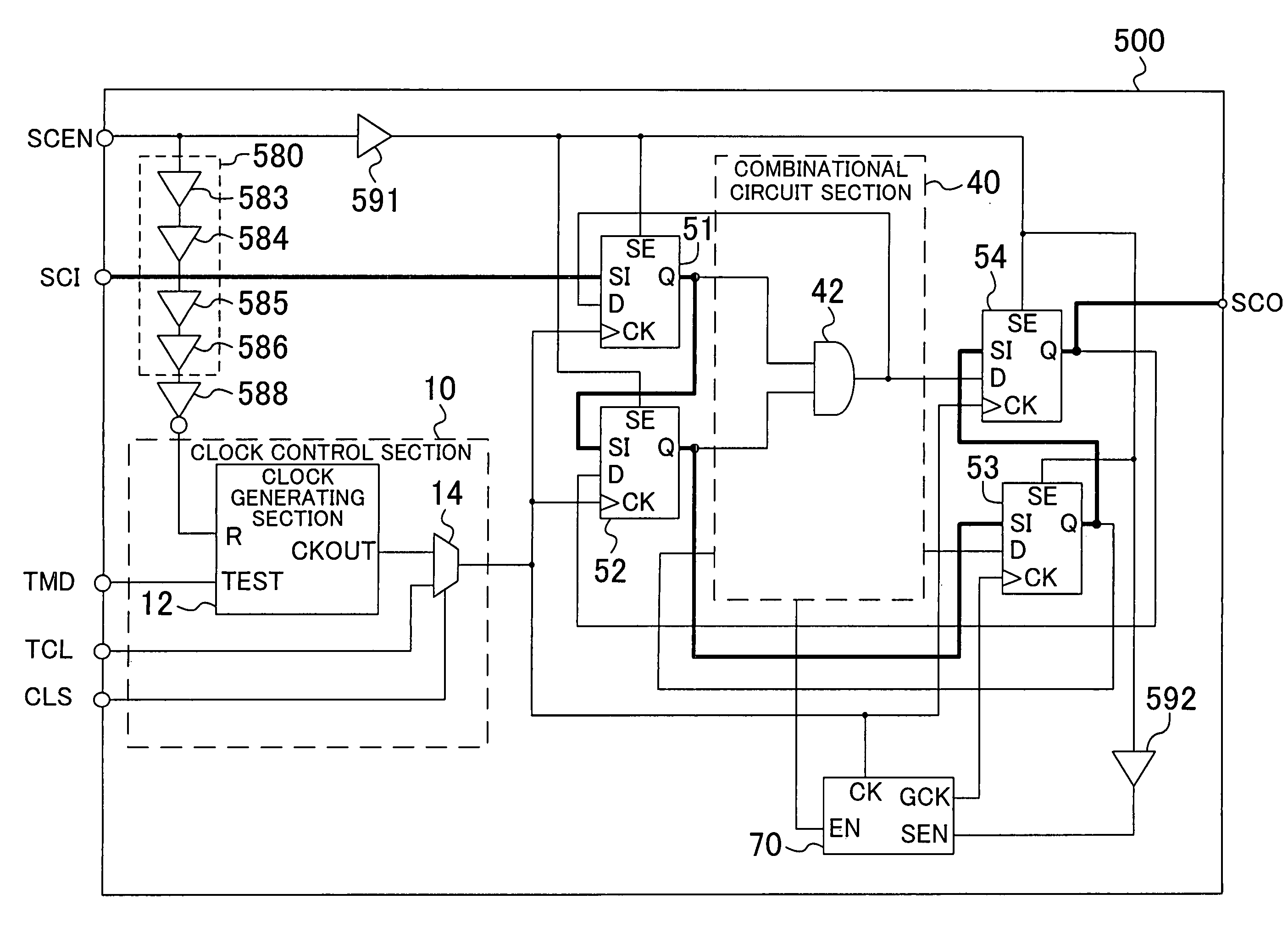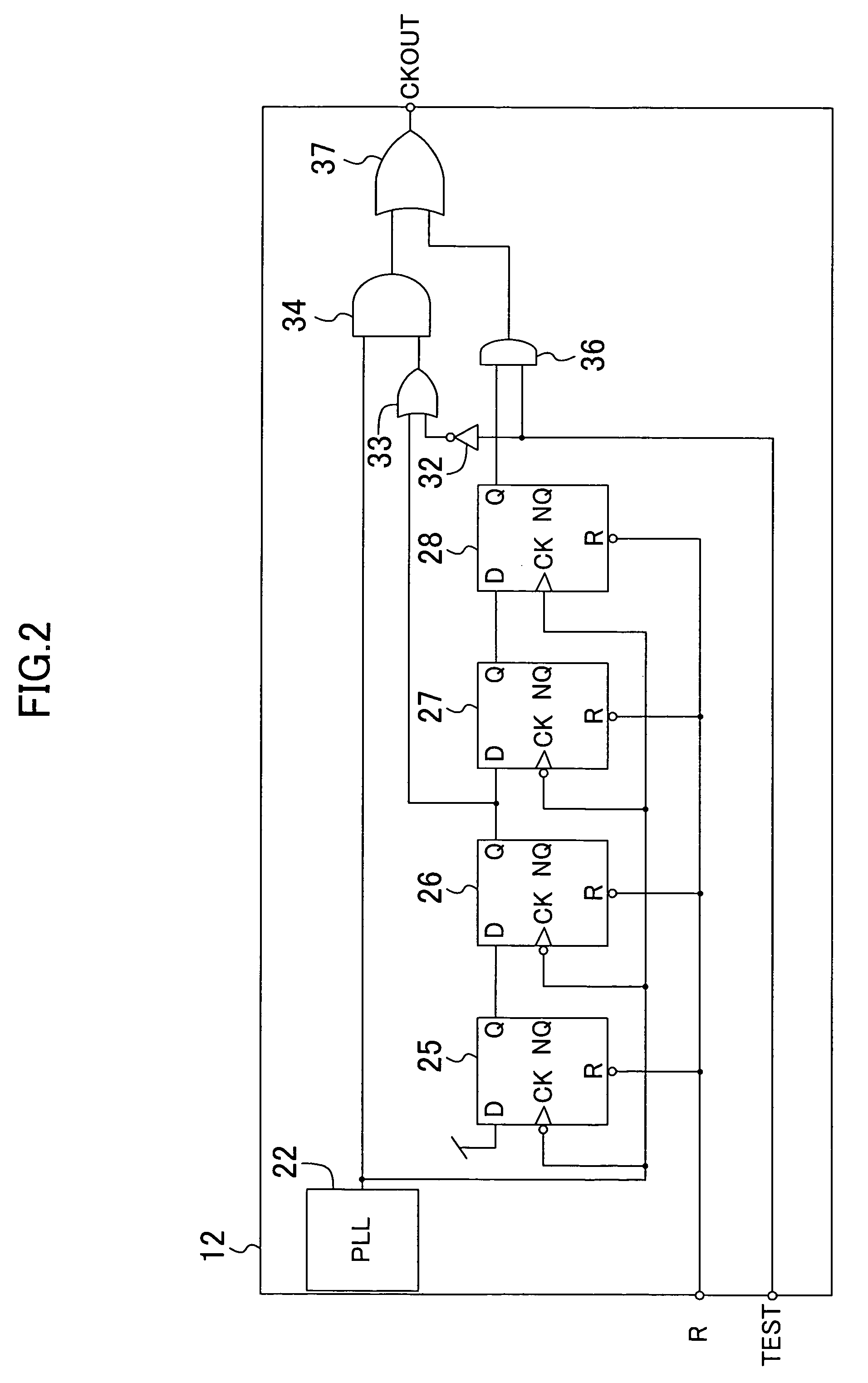Semiconductor integrated circuit, and designing method and testing method thereof
a technology of semiconductor integrated circuit and design method, applied in the direction of electronic circuit testing, measurement devices, instruments, etc., can solve the problems of increasing the difficulty of testing semiconductor integrated circuits, increasing the scale and complexity of semiconductor integrated circuits, and increasing the frequency of operation failures
- Summary
- Abstract
- Description
- Claims
- Application Information
AI Technical Summary
Benefits of technology
Problems solved by technology
Method used
Image
Examples
first embodiment
[0077]FIG. 1 is a block diagram illustrating a semiconductor integrated circuit according to a first embodiment of the present invention. The semiconductor integrated circuit 100 of FIG. 1 comprises a clock control section 10, a combinational circuit section 40, scan flip-flops 51, 52, 53 and 54, and a gated clock circuit 70 as a clock stop control circuit. The clock control section 10 comprises a clock generating section 12, and a selector 14 as a selection section. The combinational circuit section 40 comprises an AND gate 42. The scan flip-flops 51 to 54 constitute a scan path circuit.
[0078]The gated clock circuit 70 controls supply of a clock to the scan flip-flop 53. A scan-in terminal SCI, the scan flip-flop 51, the scan flip-flop 52, the scan flip-flop 53, the scan flip-flop 54, and the scan-out terminal SCO are connected together so as to transfer data in this order, constituting a scan chain. The combinational circuit section 40 is operated, depending on changes in output s...
second embodiment
[0109]FIG. 7 is a block diagram illustrating a semiconductor integrated circuit according to a second embodiment of the present invention. The semiconductor integrated circuit 200 of FIG. 7 is the same as the semiconductor integrated circuit 100 of FIG. 1, except that a clock control section 210 is provided instead of the clock control section 10. The clock control section 210 comprises a clock generating section 212 and a selector 14. Parts other than the clock generating section 212 are similar to those of the first embodiment and are indicated with the same reference numerals, and will not be described.
[0110]FIG. 8 is a circuit diagram illustrating an exemplary configuration of the clock generating section 212 of FIG. 7. The clock generating section 212 is the same as the clock generating section 12 of FIG. 2, except that a counter circuit section 224 as a period control circuit is provided instead of the flip-flops 25 and 26.
[0111]FIG. 9 is a circuit diagram illustrating an exem...
third embodiment
[0119]FIG. 10 is a block diagram illustrating a semiconductor integrated circuit according to a third embodiment of the present invention. The semiconductor integrated circuit 300 of FIG. 10 is the same as the semiconductor integrated circuit 100 of FIG. 1, except that a clock control section 310 is provided instead of the clock control section 10. The clock control section 310 comprises a clock generating section 312 and a selector 14. A test clock signal input to the test clock terminal TCL is also input to the clock generating section 312. Parts other than the clock generating section 312 are similar to those of the first embodiment and are indicated with the same reference numerals, and will not be described.
[0120]FIG. 11 is a circuit diagram illustrating an exemplary configuration of the clock generating section 312 of FIG. 10. The clock generating section 312 is the same as the clock generating section 12 of FIG. 2, except that a flip-flop 329 is further provided. An output of...
PUM
 Login to View More
Login to View More Abstract
Description
Claims
Application Information
 Login to View More
Login to View More - R&D
- Intellectual Property
- Life Sciences
- Materials
- Tech Scout
- Unparalleled Data Quality
- Higher Quality Content
- 60% Fewer Hallucinations
Browse by: Latest US Patents, China's latest patents, Technical Efficacy Thesaurus, Application Domain, Technology Topic, Popular Technical Reports.
© 2025 PatSnap. All rights reserved.Legal|Privacy policy|Modern Slavery Act Transparency Statement|Sitemap|About US| Contact US: help@patsnap.com



